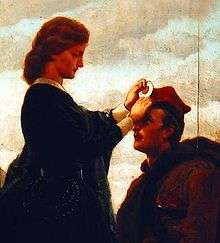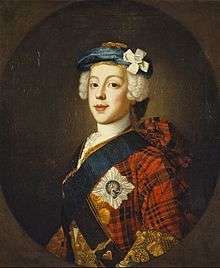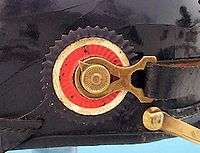Cockade


A cockade is a knot of ribbons, or other circular- or oval-shaped symbol of distinctive colours which is usually worn on a hat.
Eighteenth century
In the 18th and 19th centuries, coloured cockades were used in Europe to show the allegiance of their wearers to some political faction, their rank, or as part of a servant's livery.[1][2] Military uniforms would use cockades as well.
A cockade was pinned on the side of a man's tricorne or cocked hat, or on his lapel. Women could also wear it on their hat or in their hair.
In pre-revolutionary France, the cockade of the Bourbon dynasty was all white.[3][4][5] In the Kingdom of Great Britain supporters of a Jacobite restoration wore white cockades, while the recently established Hanoverian monarchy used a black cockade.[6][7][8][9]
During the 1780 Gordon Riots in London the blue cockade became a symbol of anti-government feelings and was worn by most of the rioters.[10][11][12][13][14][15][16][17]
During the American Revolution, the Continental Army initially wore cockades of various colors as an ad hoc form of rank insignia, as General George Washington wrote:
As the Continental Army has unfortunately no uniforms, and consequently many inconveniences must arise from not being able to distinguish the commissioned officers from the privates, it is desired that some badge of distinction be immediately provided; for instance that the field officers may have red or pink colored cockades in their hats, the captains yellow or buff, and the subalterns green.[18][19]
Before long however, the Continental Army reverted to wearing the black cockade they inherited from the British. Later, when France became an ally of the United States, the Continental Army pinned the white cockade of the French Ancien Régime onto their old black cockade; the French reciprocally pinned the black cockade onto their white cockade, as a mark of the French-American alliance. The black-and-white cockade thus became known as the "Union Cockade".[20][21][22][23][24]
In the Storming of the Bastille, Camille Desmoulins initially encouraged the revolutionary crowd to wear green; this colour was later rejected as it was associated with the reactionary Count of Artois. Instead revolutionaries would wear cockades with the traditional colours of the arms of Paris, red and blue. Later the Bourbon white was added to this cockade - thus producing the original Tricolore cockade.[23] Later, distinctive colours and styles of cockade would indicate the wearer's faction—although the meanings of the various styles were not entirely consistent, and varied somewhat by region and period.
Cockades of the Confederate States
Echoing their use when Americans rebelled against Britain, cockades – usually made with blue ribbons and worn on clothing or hats – were widespread tokens of southern support for secession preceding the American Civil War of 1861–1865.[25]
Cockades of the European military

From the 15th century various European monarchy realms used cockades to denote the nationalities of their military.[26][27][28] Their origin reverts to the distinctive colored band or ribbon worn by late medieval armies or jousting knights on their arms or headgear to distinguish friend from foe in the field of battle. Ribbon-style cockades were worn later on helmets and brimmed hats or tricornes and bicornes just as the French did, and also on cocked hats and shakoes; metal cockades were worn at the right side of helmets; small button-type cockades were worn at the front of kepis and peaked caps.[29][30]
During the Napoleonic wars, the armies of France and Russia, had the imperial French cockade or the larger cockade of St. George pinned on the front of their shakos.[31]
The Second German Empire (1870–1918) used two cockades on each army headgear: one (black-white-red) for the empire; the other for one of the monarchies the empire was composed of, which had used their own colors long before. The only exceptions were the Kingdoms of Bavaria and Württemberg, having preserved the right to keep their own armed forces which were not integrated in the Imperial Army. Their only cockades were either white and blue (Bavaria) or black-red-black (Württemberg).[32][1][33]
The Weimar Republic (1919–1933) removed these, as they might promote separatism which would lead to the dissolution of the German nation-state into regional countries again.[34] In the Second World War, the Nazis, who hated the republican German colours black-red-gold used by the Weimar Republic, reintroduced the imperial colours (in German: die kaiserlichen Farben or Reichsfarben) of black on the outside, then white, and red on the inside were used on all army caps.[35] These colours represented the biggest and the smallest countries of the Reich, Prussia (black and white) and the Hanseatic City States of Hamburg, Bremen and Lübeck (white and red).
France began the first Air Service in 1909 and soon picked the traditional French cockade as the first national emblem, now usually termed a roundel, on military aircraft. During World War I, other countries adopted national cockades and used these coloured emblems as roundels on their military aircraft. These designs often bear an additional central device or emblem to further identify national aircraft, those from the French navy bearing a black anchor within the French cockade.[36]
Hungarian revolutionaries wore cockades during the Hungarian revolution of 1848 and during the 1956 revolution. Because of this, Hungarians traditionally wear cockades on 15 March.[37][38]
List of national cockades
Below is a list of national cockades (colors listed from center to ring):[39][40]
- Argentina: sky blue-white-sky blue
- Armenia: red-blue-orange
- Austria (before 1918): black-gold
- Austria (current since 1918): red-white-red
- Belgium: black-yellow-red
- Bolivia: red-yellow-green
- Bulgaria: red-green-white
- Brazil: blue-yellow-green or yellow-green
- Chile: blue-white-red with a white 5 pointed star in the blue portion
- Colombia: yellow-blue-red
- Denmark: red-white-red
- Ecuador: red-blue-yellow
- Estonia: white-black-blue
- Finland: white-blue-white
- France (1794–1814, 1815 and current since 1830): blue-white-red
- France (before 1794, 1814–1815 and 1815–1830): white
- Germany (1918–1932 and since 1945): black-red-gold
- Germany (1871–1918 and 1932–1945): red-white-black
- Component states of the German Empire (1871–1918):
- Anhalt: green
- Baden: yellow-red-yellow
- Bavaria: white-sky blue-white
- Bremen: white-red-white
- Brunswick: blue-yellow-blue
- Hamburg: white with a red cross
- Hesse: white-red-white-red-white
- Lippe: red-yellow
- Lübeck: white with a red Maltese cross
- Mecklenburg: red-yellow-blue
- Oldenburg: blue-red-blue
- Prussia: black-white-black
- Saxony: green-white-green
- Saxe-Weimar: black-yellow-green
- Schaumburg-Lippe: blue-red-white
- Schwarzburg-Rudolstadt: blue-white-blue
- Schwarzburg-Sonderhausen: white-blue-white
- Waldeck-Reuss: black-red-yellow
- Württemberg: black-red-black
- German Confederation (1848–1871): gold-red-black
- Greece: blue-white
- Hungary: red-white-green
- India : saffron-white-green
- Iran: red-white-green
- Ireland (current since 1922): green-white-orange
- Ireland (before 1922): green or sky blue
- Italy (current since 1848): green-white-red
- Italy (before 1848): blue savoy
- Japan: red
- Mexico: green-white-red
- Monaco: red-white
- Netherlands: orange
- Norway: red-white-blue-white
- Paraguay: blue-white-red
- Peru: red-white-red
- Poland: white-red
- Portugal (current since 1910): green-red
- Portugal (1821–1823 and 1830–1910): blue-white
- Portugal (1797–1821 and 1823–1830): blue-red
- Romania: blue-yellow-red
- Russia: red-blue-white
- Russia (military - Cockade of St. George): black-orange-black-orange
- San Marino: white-blue
- Serbia: white-blue-red
- Spain (1843–1844 and current since 1871): red-yellow-red
- Spain (until 1843 and 1844–1871): red
- Sweden:
- military: yellow
- civil: yellow-blue
- Turkey: red-white-red
- United Kingdom (Stuart dynasty): orange
- United Kingdom (Hanoverian dynasty): black
- Uruguay (civil): white-blue-white-blue-white-blue-white-blue-white
- United States of America (current): blue-white-red
- United States of America (19th century): black with an eagle in the centre
- United States of America (War of Independence - Union Cockade): white-black
- United States of America (War of Independence - Triple Alliance): white-black-red
- Uruguay (military - Cockade of Artigas): blue-white-blue with a red diagonal line
- Uruguay (police): red-white-blue
- Venezuela: red-blue-yellow
See also
References
- 1 2 Maxwell, A. (2014). Patriots Against Fashion: Clothing and Nationalism in Europe’s Age of Revolutions. Palgrave Macmillan UK. ISBN 9781137277145. Retrieved 2017-03-05.
- ↑ Newman, S.P. (2010). Parades and the Politics of the Street: Festive Culture in the Early American Republic. University of Pennsylvania Press, Incorporated. p. 161. ISBN 9780812200478. Retrieved 2017-03-05.
- ↑ The White Cockade; Or, Bourbon Songster: Being a Patriotic Collection of Songs on the Downfall of Tyranny, and Restoration of Louis XVIII., Etc. [A Chap-book.]. J. Evans & Son. 1814. p. 2. Retrieved 2017-03-05.
- ↑ Cobbett, W. (1814). Cobbett's Political Register. 25. William Cobbett. Retrieved 2017-03-05.
- ↑ Jones, C. (2006). Paris: Biography of a City. Penguin Books Limited. ISBN 9780141941912. Retrieved 2017-03-05.
- ↑ Cormack, W.S. (2002). Revolution and Political Conflict in the French Navy 1789-1794. Cambridge University Press. p. 65. ISBN 9780521893756. Retrieved 2017-03-05.
- ↑ Hofschröer, P.; Fosten, B. (2012). The Hanoverian Army of the Napoleonic Wars. Bloomsbury Publishing. ISBN 9781780965178. Retrieved 2017-03-05.
- ↑ Jones, G.M. (1827). Travels in Norway, Sweden, Finland, Russia and Turkey: also on the coasts of the sea of Azof and of the Black sea; with a review of the trade in those seas, and of the systems adopted to man the fleets of the different powers of Europe, compared with that of England. J. Murray. p. 22. Retrieved 2017-03-05.
- ↑ Franklin, C. (2012). British Army Uniforms of the American Revolution 1751-1783. Pen & Sword Books Limited. p. 111. ISBN 9781848846906. Retrieved 2017-03-05.
- ↑ Babington, A. (2015). Military Intervention in Britain: From the Gordon Riots to the Gibraltar Incident. Taylor & Francis. p. 21. ISBN 9781317397717. Retrieved 2017-03-05.
- ↑ Stockdale, J.J. (1810). The Covent Garden Journal ... J.J. Stockdale. p. 130. Retrieved 2017-03-05.
- ↑ Livingston, D.W. (1998). Philosophical Melancholy and Delirium: Hume's Pathology of Philosophy. University of Chicago Press. p. 275. ISBN 9780226487175. Retrieved 2017-03-05.
- ↑ Popular educator (1767). The popular educator. p. 254. Retrieved 2017-03-05.
- ↑ Bloom, C. (2012). Riot City: Protest and Rebellion in the Capital. Palgrave Macmillan. p. 147. ISBN 9781137029362. Retrieved 2017-03-05.
- ↑ Walker, G.; Verhoeven, W.M. (2004). The Vagabond. Broadview Press. p. 253. ISBN 9781460404256. Retrieved 2017-03-05.
- ↑ CLIFFORD, H.; Brandon, J. (1809). Clifford fo ever! O.P. and no P.B. The Trial between H. Clifford, plaintiff, and J. Brandon, defendant, for an assault and false imprisonment, etc. John Fairburn. p. 19. Retrieved 2017-03-05.
- ↑ Haywood, I.; Seed, J. (2012). The Gordon Riots: Politics, Culture and Insurrection in Late Eighteenth-Century Britain. Cambridge University Press. p. 107. ISBN 9780521195423. Retrieved 2017-03-05.
- ↑ "Defense.gov News Article: Insignia: The Way You Tell Who's Who in the Military". archive.defense.gov. Retrieved 2017-03-05.
- ↑ Force, P. (1844). American archives. Рипол Классик. pp. 2–1745. ISBN 9785885286961. Retrieved 2017-03-05.
- ↑ Field, R.; Hook, A. (2013). LincolnÂ?s 90-Day Volunteers 1861: From Fort Sumter to First Bull Run. Bloomsbury Publishing. p. 47. ISBN 9781782009214. Retrieved 2017-03-05.
- ↑ Richards, J.H. (1997). Early American Drama. Penguin Publishing Group. p. 68. ISBN 9781101177211. Retrieved 2017-03-05.
- ↑ Winkle, K.J. (2013). Lincoln's Citadel: The Civil War in Washington, DC. W. W. Norton. ISBN 9780393240573. Retrieved 2017-03-05.
- 1 2 Maxwell, A. (2014). Patriots Against Fashion: Clothing and Nationalism in Europe’s Age of Revolutions. Palgrave Macmillan UK. ISBN 9781137277145. Retrieved 2017-03-05.
- ↑ Fahs, A. (2010). The Imagined Civil War: Popular Literature of the North and South, 1861-1865. University of North Carolina Press. p. 43. ISBN 9780807899298. Retrieved 2017-03-05.
- ↑ http://opinionator.blogs.nytimes.com/2010/11/15/female-partisans/ New York Times blogs
- ↑ ADYE, R.W. (1802). The Little Bombardier, and Pocket Gunner. By Ralph Willett Adye. T. Egerton. p. 271. Retrieved 2017-03-05.
- ↑ Troiani, D.; Kochan, J.L.; Coates, J.; Kochan, J. (1998). Don Troiani's Soldiers in America, 1754-1865. Stackpole Books. p. 99. ISBN 9780811705196. Retrieved 2017-03-05.
- ↑ Lockmiller, A. (2012). Teacher's Guide for Beau, Doctor of France. Lulu.com. p. 32. ISBN 9781105786174. Retrieved 2017-03-05.
- ↑ Stone, D. (2015). The Kaiser's Army: The German Army in World War One. Bloomsbury Publishing. ISBN 9781844862924. Retrieved 2017-03-05.
- ↑ Kidd, R.S. (2013). MILITARY UNIFORMS IN EUROPE 1900 - 2000 Volume One. LULU Press. p. 128. ISBN 9781291187441. Retrieved 2017-03-05.
- ↑ Dempsey, G. (2002). Napoleon's Mercenaries: Foreign Units in the French Army Under the Consulate and Empire, 1799-1814. Greenhill Books. p. 267. ISBN 9781853674884. Retrieved 2017-03-05.
- ↑ Kidd, R.S. (2013). MILITARY UNIFORMS IN EUROPE 1900 - 2000 Volume One. LULU Press. p. 5. ISBN 9781291187441. Retrieved 2017-03-05.
- ↑ D, D.T.Z.P. (2014). Germany at War: 400 Years of Military History [4 volumes]: 400 Years of Military History. ABC-CLIO. p. 494. ISBN 9781598849813. Retrieved 2017-03-05.
- ↑ Williamson, G.; Pavlovic, D. (2012). U-Boat Crews 1914–45. Bloomsbury Publishing. ISBN 9781780967905. Retrieved 2017-03-05.
- ↑ de Quesada, A.; Dale, C.; Walsh, S. (2013). Imperial German Colonial and Overseas Troops 1885?1918. Bloomsbury Publishing. p. 47. ISBN 9781780961651. Retrieved 2017-03-05.
- ↑ Cooke, J.J. (1996). The U.S. Air Service in the Great War, 1917-1919. Praeger. p. 202. ISBN 9780275948627. Retrieved 2017-03-05.
- ↑ Wöll, A.; Wydra, H. (2007). Democracy and Myth in Russia and Eastern Europe. Taylor & Francis. p. 182. ISBN 9781134089086. Retrieved 2017-03-05.
- ↑ Gyarfasova, O.; Liebhart, K. (2014). Constructing and Communicating Europe. Lit Verlag. p. 202. ISBN 9783643905154. Retrieved 2017-03-05.
- ↑ "Tableau comparatif de la superficie, population totale et pop. par m. géogr. de tous les Etats du monde, avec les cocardes et pavillons les plus connus / dressé d'après Malte-Brun, Hassel, Balbi et autres sources authentiques par C. Desjardins ; A. Haas, script. | Gallica, 1833". gallica.bnf.fr. Retrieved 2017-03-05.
- ↑ "Tableau comparatif de la superficie et de la population absolue et relative de tous les Etats du monde avec leurs pavillons et cocardes / dressé d'après les documens les plus récens par Ct. Desjardins,... ; Lith. de Mantoux,... | Gallica, 1842". gallica.bnf.fr. Retrieved 2017-03-05.
Further reading
External links
| Wikimedia Commons has media related to Cockades. |